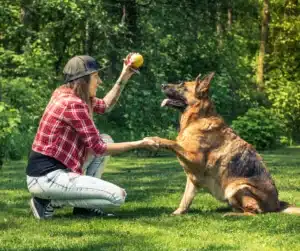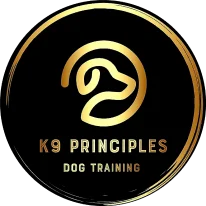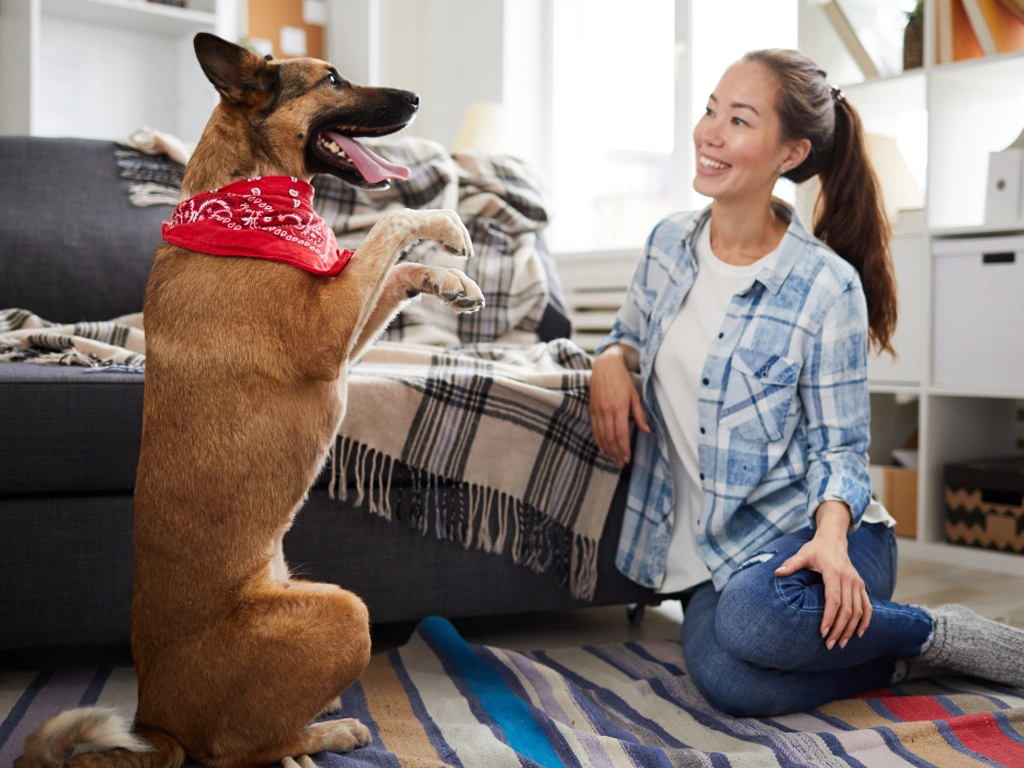Why Isn’t My Dog Learning? Unpacking Common Training Hurdles
Embarking on the journey of dog training is much like the intricate process of raising a child. It demands patience, understanding, and a commitment to nurturing growth and learning over time. This endeavour transcends the mere teaching of commands; it’s fundamentally about building a bond that allows your canine companion to thrive within the family and societal settings. It’s an investment of more than just time and effort; it’s about creating a deep-seated connection between dog and owner, ensuring the safety and well-being of both.
 Yet, as many dog owners navigate this journey, they often encounter a lack of progress satisfactory to their expectations. This often creates frustration felt by those who, despite their financial investment in comprehensive training courses, find their dogs not living up to the envisioned standards of obedience and behaviour expressed by their trainer. This gap between expectation and reality prompts a critical question: where does the disconnect lie?
Yet, as many dog owners navigate this journey, they often encounter a lack of progress satisfactory to their expectations. This often creates frustration felt by those who, despite their financial investment in comprehensive training courses, find their dogs not living up to the envisioned standards of obedience and behaviour expressed by their trainer. This gap between expectation and reality prompts a critical question: where does the disconnect lie?
Understanding Positive Reinforcement Dog Training
Positive reinforcement dog training operates on a simple yet powerful principle: rewarding your dog for desirable behaviours encourages them to repeat those behaviours. Similar to how a child feels motivated by praise or treats, dogs are more likely to exhibit behaviours that result in positive outcomes. Whether it’s a tasty treat, a favourite toy, or verbal praise, the essence of this method is clear communication of approval, fostering a positive learning environment.
Navigating Common Challenges in Dog Training
 Despite its effectiveness, several challenges can arise during the training process. Recognising and addressing these hurdles early on can significantly enhance your training efforts and could be the reason why your dog is not meeting the desired expectations:
Despite its effectiveness, several challenges can arise during the training process. Recognising and addressing these hurdles early on can significantly enhance your training efforts and could be the reason why your dog is not meeting the desired expectations:
- Inconsistency: A major stumbling block in dog training is inconsistency. Dogs learn best with clear, consistent guidelines and messages. Inconsistent commands, rules or body language can lead to confusion and unpredictable behaviour. For example, if you allow your dog on the sofa one day but scold them for the same action the next, it sends mixed signals. Maintaining consistency in commands, rewards, and rules is crucial for effective training.
- Low Reinforcement Value: The cornerstone of positive reinforcement is the value of the reward. A reward that holds little to no appeal for your dog will hardly motivate them towards the desired behaviour. Identifying what your dog truly values—whether it’s a specific type of treat, a play session, or verbal praise—is key. The reward must be immediate and desirable to reinforce the behaviour effectively.
- Distractions: Training in an environment laden with distractions can severely hinder your dog’s ability to focus and learn. It’s akin to trying to study in a noisy, crowded room.
- Unrealistic Expectations: Training is a journey that requires time, patience, and realistic expectations. Expecting immediate or rapid progress can lead to frustration for both you and your dog. It’s important to understand that each dog learns at their own pace. Setting achievable, incremental goals fosters a positive and encouraging training environment.
- Lack of Homework: Training doesn’t end when the formal session is over. Regular practice and reinforcement of learned behaviours at home are crucial. This is akin to students doing homework to reinforce what they’ve learned in school. Without consistent practice, dogs may forget or fail to fully integrate the behaviours into their routine. Repetition is how dogs learn.
- Not Making Training Fun: If training sessions become monotonous or too serious, both you and your dog may lose interest. Training should be an enjoyable activity, incorporating games and playful challenges to keep the sessions engaging. This approach not only makes learning more enjoyable but also strengthens your bond with your dog.
- Breed-Specific Challenges: It’s essential to recognize that not all dogs learn at the same pace, and indeed, some breeds present unique training challenges. For instance, scenting breeds, known for their keen sense of smell, may find it particularly challenging to master recall commands if distracted by an interesting scent. This doesn’t mean they can’t learn; it simply means their training might require more patience and tailored strategies. Expecting the same recall reliability from a scent-driven breed as from one less inclined to follow their nose is unrealistic and unfair. Understanding and respecting the innate tendencies of your dog’s breed can significantly influence the approach and expectations in training.
- Health and Well-being: No training program, no matter how well-designed, can succeed if your dog isn’t in good health. Dogs who are unwell, injured, or under the weather often lack the focus or motivation to engage in learning. Their discomfort or pain can overshadow their ability to concentrate or even respond to positive reinforcement. If your dog is unusually disinterested or struggling with training, it’s crucial to consider their physical health. A visit to the vet can help rule out any underlying health issues that might be affecting their ability to learn. Ensuring your dog is healthy and happy is a prerequisite for effective training.
How do we fix these issues?
The Importance of Consistency
 Consistency is the bedrock of successful dog training. It involves using the same commands, body language, and rules to provide a stable and predictable learning environment. This clarity helps your dog understand what is expected of them, thereby streamlining the training process. For instance, always using the command “sit” for the desired sitting behaviour and immediately rewarding compliance establishes a clear association in your dog’s mind. Clarity is kindness.
Consistency is the bedrock of successful dog training. It involves using the same commands, body language, and rules to provide a stable and predictable learning environment. This clarity helps your dog understand what is expected of them, thereby streamlining the training process. For instance, always using the command “sit” for the desired sitting behaviour and immediately rewarding compliance establishes a clear association in your dog’s mind. Clarity is kindness.
Choosing the Right Rewards
The effectiveness of positive reinforcement hinges on the appeal of the reward. Experimenting with different rewards can help you discover what best motivates your dog. The timing of the reward must be immediate to effectively link the behaviour with the positive outcome. This immediate gratification reinforces the desired behaviour, making it more likely to be repeated. The reward must be of higher value to the dog than the environment because the environment always wins when the value is equal. So, bring out the tastiest of treats (hot dogs, cheese, liver treats, chicken, etc.) when reinforcing newly taught skills once you start increasing the distractions. Leave their kibble for their dinner or to acknowledge good behaviour around the house.
Managing Distractions
 Gradually introducing distractions can teach your dog to respond to commands in various situations. This controlled approach allows your dog to adapt and learn to focus despite external stimuli, preparing them for real-world scenarios where distractions are inevitable. All new skills should be mastered inside your home before moving outside.
Gradually introducing distractions can teach your dog to respond to commands in various situations. This controlled approach allows your dog to adapt and learn to focus despite external stimuli, preparing them for real-world scenarios where distractions are inevitable. All new skills should be mastered inside your home before moving outside.
Setting Realistic Training Goals
Acknowledging that training is a progressive process helps in setting realistic goals. Celebrating small milestones and continuous progress is vital for maintaining motivation. Patience and understanding are key; recognising and adapting to your dog’s learning pace ensures a positive and fruitful training experience. If you would not bet your trainer $100 that your dog would do a certain cue with a dog playing ball in front of them, you need to put in more work to meet your expectations.
Incorporating Homework into Routine
Consistent reinforcement of training lessons at home solidifies your dog’s learning. Short, focused training sessions integrated into your daily routine can significantly enhance the retention and integration of behaviours. This regular practice is essential for lasting training success. A training session could be as short as 30 seconds. Knowing that, now how many training sessions could you get in during the time you are awake?
Making Training Engaging
Incorporating fun and play into training sessions not only makes them more enjoyable but also enhances the learning experience. Creative games that incorporate commands and behaviours provide mental stimulation and keep your dog engaged, making training a highly anticipated activity.
Seeking Professional Help When Needed: There’s no shame in seeking professional help if you encounter persistent challenges in your training efforts. K9 Principles can offer personalised advice and strategies tailored to your dog’s specific needs, providing a fresh perspective on overcoming training hurdles. Our in-home private training is ideal for the person who does not have a consistent work schedule as we will come to you and work with you in the environment necessary to guide you towards success. Beyond the foundational benefits of in-home training, our group classes in Caledonia, Hamilton and Brantford offer a multifaceted approach to enhancing your dog’s learning. These classes not only instil a sense of accountability and commitment in owners, ensuring regular, focused training amidst busy schedules but also provide invaluable socialisation opportunities. Here, dogs learn to focus and control their impulses as well as interact appropriately with a variety of peers and humans, addressing potential behavioural issues such as aggression or anxiety. Moreover, the expertise of the K9 Principles trainers offers personalised insights and strategies, tackling specific challenges with tailored solutions. This blend of structured learning, social exposure, and expert guidance significantly elevates the effectiveness of your dog’s training journey.
FAQs
-
A1. Inconsistency in commands and rules, low reinforcement value of rewards, distractions, unrealistic expectations, insufficient practice at home, lack of engaging training sessions, breed-specific challenges, and the dog’s health and well-being can all impact your dog’s learning process.
Conclusion
Navigating the complexities of dog training is a journey of patience, understanding, and consistency, aimed at forging a strong bond beyond basic commands. This article has highlighted key strategies to overcome training challenges, emphasising the importance of positive reinforcement, recognising breed-specific needs, and ensuring the health and well-being of our canine companions. Embracing each dog’s individuality and incorporating fun into training sessions are crucial for success. Ultimately, the essence of dog training lies in nurturing a relationship of mutual respect and understanding, leading to a harmonious and rewarding partnership between dog and owner.
- Name: K9 Principles
- Address: Haldimand County, Greater Hamilton Area, Burlington and Most of Norfolk County
- Phone: 289 880-3382
- Email: k9principlesinc@gmail.com
- Website: www.k9principles.ca



